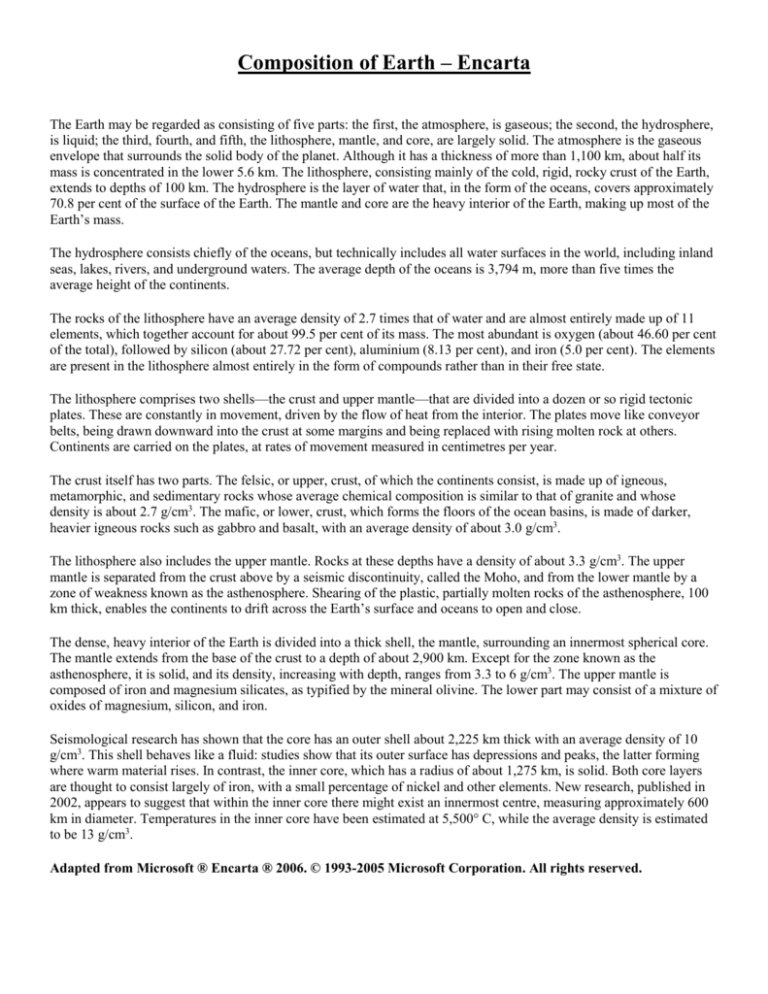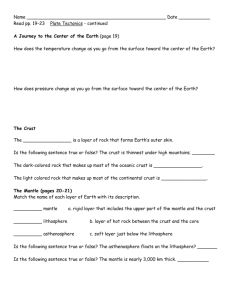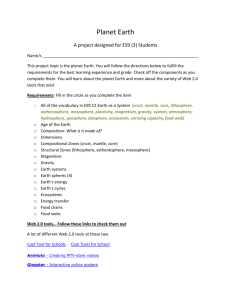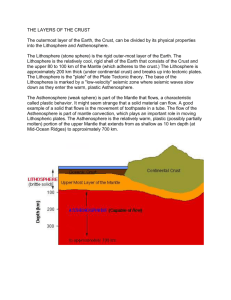
Composition of Earth – Encarta
The Earth may be regarded as consisting of five parts: the first, the atmosphere, is gaseous; the second, the hydrosphere,
is liquid; the third, fourth, and fifth, the lithosphere, mantle, and core, are largely solid. The atmosphere is the gaseous
envelope that surrounds the solid body of the planet. Although it has a thickness of more than 1,100 km, about half its
mass is concentrated in the lower 5.6 km. The lithosphere, consisting mainly of the cold, rigid, rocky crust of the Earth,
extends to depths of 100 km. The hydrosphere is the layer of water that, in the form of the oceans, covers approximately
70.8 per cent of the surface of the Earth. The mantle and core are the heavy interior of the Earth, making up most of the
Earth’s mass.
The hydrosphere consists chiefly of the oceans, but technically includes all water surfaces in the world, including inland
seas, lakes, rivers, and underground waters. The average depth of the oceans is 3,794 m, more than five times the
average height of the continents.
The rocks of the lithosphere have an average density of 2.7 times that of water and are almost entirely made up of 11
elements, which together account for about 99.5 per cent of its mass. The most abundant is oxygen (about 46.60 per cent
of the total), followed by silicon (about 27.72 per cent), aluminium (8.13 per cent), and iron (5.0 per cent). The elements
are present in the lithosphere almost entirely in the form of compounds rather than in their free state.
The lithosphere comprises two shells—the crust and upper mantle—that are divided into a dozen or so rigid tectonic
plates. These are constantly in movement, driven by the flow of heat from the interior. The plates move like conveyor
belts, being drawn downward into the crust at some margins and being replaced with rising molten rock at others.
Continents are carried on the plates, at rates of movement measured in centimetres per year.
The crust itself has two parts. The felsic, or upper, crust, of which the continents consist, is made up of igneous,
metamorphic, and sedimentary rocks whose average chemical composition is similar to that of granite and whose
density is about 2.7 g/cm3. The mafic, or lower, crust, which forms the floors of the ocean basins, is made of darker,
heavier igneous rocks such as gabbro and basalt, with an average density of about 3.0 g/cm3.
The lithosphere also includes the upper mantle. Rocks at these depths have a density of about 3.3 g/cm3. The upper
mantle is separated from the crust above by a seismic discontinuity, called the Moho, and from the lower mantle by a
zone of weakness known as the asthenosphere. Shearing of the plastic, partially molten rocks of the asthenosphere, 100
km thick, enables the continents to drift across the Earth’s surface and oceans to open and close.
The dense, heavy interior of the Earth is divided into a thick shell, the mantle, surrounding an innermost spherical core.
The mantle extends from the base of the crust to a depth of about 2,900 km. Except for the zone known as the
asthenosphere, it is solid, and its density, increasing with depth, ranges from 3.3 to 6 g/cm3. The upper mantle is
composed of iron and magnesium silicates, as typified by the mineral olivine. The lower part may consist of a mixture of
oxides of magnesium, silicon, and iron.
Seismological research has shown that the core has an outer shell about 2,225 km thick with an average density of 10
g/cm3. This shell behaves like a fluid: studies show that its outer surface has depressions and peaks, the latter forming
where warm material rises. In contrast, the inner core, which has a radius of about 1,275 km, is solid. Both core layers
are thought to consist largely of iron, with a small percentage of nickel and other elements. New research, published in
2002, appears to suggest that within the inner core there might exist an innermost centre, measuring approximately 600
km in diameter. Temperatures in the inner core have been estimated at 5,500° C, while the average density is estimated
to be 13 g/cm3.
Adapted from Microsoft ® Encarta ® 2006. © 1993-2005 Microsoft Corporation. All rights reserved.








